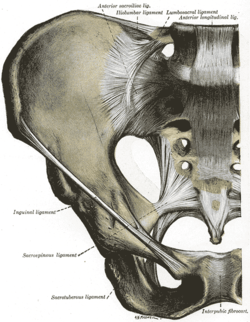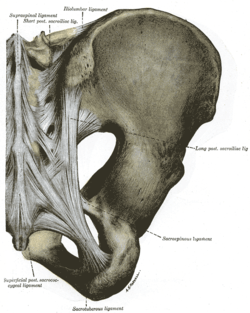Iliolumbar ligament
The iliolumbar ligament is a strong ligament passing from the tip of the transverse process of the fifth lumbar vertebra to the posterior part of the inner lip of the iliac crest (upper margin of ilium).[1]
| Iliolumbar ligament | |
|---|---|
 Articulations of pelvis. Anterior view (iliolumbar ligament labeled at center top) | |
 Articulatios of pelvis. Posterior view (iliolumbar ligament labeled at center top) | |
| Details | |
| From | Transverse process of fifth lumbar vertebra |
| To | Posterior part of iliac crest |
| Identifiers | |
| Latin | Ligamentum iliolumbale |
| TA | A03.2.07.002 |
| FMA | 21493 |
| Anatomical terminology | |
Course
It forms the thickened lower border of two of the layers of the thoracolumbar fascia. Occasionally, a small ligamentous band stretches from the tip of the transverse process of the fourth vertebra down to the iliac crest behind the main ligament. Usually, fibrous strands are found between this latter process and the iliac crest, but these are only considered a true ligament when dense enough.[1]
It radiates as it passes laterally and is attached by two main bands to the pelvis. The lower bands run to the base of the sacrum, blending with the anterior sacroiliac ligament; the upper is attached to the crest of the ilium immediately in front of the sacroiliac articulation, and is continuous above with the lumbodorsal fascia. In front, it is in relation with the Psoas major; behind, with the muscles occupying the vertebral groove; above, with the Quadratus lumborum. [2]
Function
The iliolumbar ligament strengthens the lumbosacral joint assisted by the lateral lumbosacral ligament, and, like all other vertebral joints, by the posterior and anterior longitudinal ligaments, the ligamenta flava, and the interspinous and supraspinous ligaments.[1]
References
This article incorporates text in the public domain from page 306 of the 20th edition of Gray's Anatomy (1918)
- Palastanga, Nigel; Field, Derek; Soames, Roger (2006). Anatomy and Human Movement: Structure and Function. Elsevier Health Sciences. pp. 332–333. ISBN 0-7506-8814-9.
-
- Gray, Henry (1918). "Articulation of the Vertebral Column with the Pelvis". Anatomy of the Human Body. Bartleby. p. 306.
External links
- pelvis at The Anatomy Lesson by Wesley Norman (Georgetown University) (pelvisposteriorligaments)